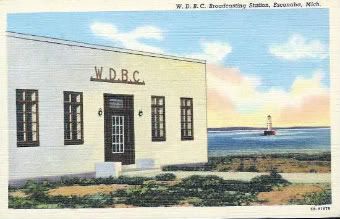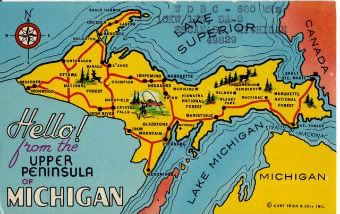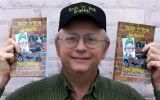
Before moving to downtown Escanaba,
radio station WDBC was broadcast from this
building on Sand Point which now houses the
Delta County Historical Museum.
By STEVE SEYMOUR
It seems like radio has always been part of my life. I got hooked as a young person when AM signals dominated the airwaves in the Upper Peninsula and local FM stations were years away.
The table top radio at our house in the 1960s was located on the counter next to the refrigerator. It was tuned to WDBC, 680 on the dial, and was the first thing we'd hear when we came downstairs in the morning.
My brothers and sisters and I would eat breakfast while listening to local news and pop music as broadcast from the studio located at 604 Ludington St. We'd listen intently after a snowstorm, hoping to hear an announcement that school was cancelled. We also looked forward to the "bus riders special" when a tune requested by a student would be played.
WDBC attracted many households in the region because it was authorized to broadcast with a signal measuring 10,000 watts during the day and 1,000 at night. As the most powerful station in the U. P., WDBC's signal could be heard from Iron River to St. Ignace and as far away as Green Bay, Wis. Many communities in lower Michigan were also able to tune in.
Chief engineer Dean W. Manley often sent postcards with a map of the U. P. on the front to faraway listeners confirming their reception reports.
Actually, WDBC began broadcasting in 1941 from the building on Sand Point which now houses the Delta County Historical Museum and moved to a downtown location after World War II.
By 1958, a competing station was formed when WLST began operating from the second story of the Escanaba Daily Press building. The call letters were an abbreviation for Ludington St., while the frequency was the same 600 number in the station's address.
Programming for WLST proved challenging for studio manager Don Lang. "We try to please everyone, and of course that isn't possible" Lang said in 1965.
"We get more requests for music preferences than we used to and in our programming we try for middle of the road in public taste, we try for variety and we try for an accent on easy listening.
"We try to avoid hard rock and roll except on Saturday afternoons when we surrender to the kids because we're not on at night, but there are a lot of adults who like rock and roll too. It comes out of our country western music. The great volume of radio music though, is not rock and roll."
Although WLST was a local alternative, the station pushed out a comparatively weak 1,000 watts and signed off the air at dusk.
And, dusk was when many radio stations became the dominion of teenagers. WDBC hired announced William J. Schinzel, better known as Billy John, to cater to this burgeoning age group. He took requests by phone and played Top Forty material for teenagers at home and those driving around listening in their cars.
Schinzel even had his own fan club, B. J.'s Army, headed for a brief time by Ronese Nantelle, a student from Wells.
On many nights my friend Bob Nygaard and I would "bomb the drag," blasting the radio as we cruised Ludington St. from the A&W Root Beer stand at 22nd St.on the west end to WDBC at 6th St. on the east end and back again.
With so much time listening to the radio, Bob and I became experts in identifying songs and played our own version of "Name That Tune." The first to name the songs we heard got a point until a winner was declared when five or ten points were gained.
We would keep rockin' when WDBC signed off by switching to Chicago station WLS at 890 or WCFL at 1000, both staffed by popular deejays fueled by 50,000 watts of clear channel power. In fact, Ishpeming native Kris Erik Stevens managed to spin records for both stations in late 60s and early 70s.
When the FM format began to proliferate, providing listeners with more choices, both AM radio broadcasting and rock 'n' roll changed.
Since FM delivered better sound quality, music programming migrated to a new home, while many AM stations switched to a talk radio.
Like me, Dyrk Trout of Escanaba spent time listening to WDBC. While tuned to the station during one evening in 1966, he heard an announcement mentioning Ronese Nantelle, who headed the fan club of DJ Billy John. Decades passed.
Then, when Trout was at the 8th Street Coffee House in 1998, he met a customer called Ronnie who was visiting Escanaba from her home in Denver. Trout asked her what "Ronnie" was short for. "Ronese," she replied. "Ronese Nantelle?" Trout asked. "Yes," she said.
Trout finally met Ronese Nantelle in person after hearing her name on the radio 32 years before, remembering her name all along.
Turning from a listener to an employee, Trout also worked for WDBC in 1979-80. DJ Billy John Schinzel still worked for the station at that time and was assigned to do a remote broadcast. Schinzel, who suffered from anxiety attacks, said he was not willing to do the job. Station management let Schinzel go over the disagreement, Trout recalled.
For a time, I had an aspiration for a career in radio. In 1973, with a fresh degree in journalism, I approached WBDN (the successor to WLST) for a job. DJ and radio personality Bruce Nelson was very kind in regards to my application.
During a visit to the station, he ripped some copy from the newswire and asked me to read it on tape. The microphone wasn't my friend. After listening to my enunciation, Nelson told me I had a "lazy tongue," and I gave up on any radio career.
I specifically remember listening to the radio once in 1963 when the deejay spun a record from 1959. As a 12-year-old, I wondered why the station would bother to play a song that was four years old when there were so many great contemporary hits.
Today, "oldies" comprise a popular radio format and I'm still listening.


 I've enjoyed rock music and writing since I was a teenager in the 60s. I feel lucky to have been around when rock's greatest stars created their most enduring hits. At the same time I found I enjoyed writing, as well. I worked on my high school newspaper and magazine, was editor of several college publications and earned a bachelor's degree from Central Michigan University in 1973. I worked for the daily newspaper in my hometown after graduating, becoming managing editor after a few years. By the 1980s, I moved into public relations. In 1985, my wife Sue and I opened a retail music store, The Record Rack, which we still own. Rock 'n' roll has been integral to me and for the last 2O years I've been earning my living from it even though I don't have a musical bone in my body. In recent years, I've also I edited a small local magazine and launched a micro FM radio station. Now, I'm finally combining my love of writing and rock 'n' roll. I can't sing a note, but I know what I like. I'll tell you all about it when you read on. I hope you have as much enjoyment reading these installments as I've had writing them.
I've enjoyed rock music and writing since I was a teenager in the 60s. I feel lucky to have been around when rock's greatest stars created their most enduring hits. At the same time I found I enjoyed writing, as well. I worked on my high school newspaper and magazine, was editor of several college publications and earned a bachelor's degree from Central Michigan University in 1973. I worked for the daily newspaper in my hometown after graduating, becoming managing editor after a few years. By the 1980s, I moved into public relations. In 1985, my wife Sue and I opened a retail music store, The Record Rack, which we still own. Rock 'n' roll has been integral to me and for the last 2O years I've been earning my living from it even though I don't have a musical bone in my body. In recent years, I've also I edited a small local magazine and launched a micro FM radio station. Now, I'm finally combining my love of writing and rock 'n' roll. I can't sing a note, but I know what I like. I'll tell you all about it when you read on. I hope you have as much enjoyment reading these installments as I've had writing them.


2 comments:
I enjoyed your article, Steve. I
too grew up with WDBC. I was born
and raised in Escanaba. I left for
the U.S. Navy in 1956 and finally
retired in Florida. I remember the
"good ole days", i.e., the 12:30
Polka Show, Gabriel Heater and
others. Thanks for the memories!
Vic Sopina
Whatever happened to Billy John? I grew up in the 70's & remember listening to WDBC and his nightly 'requests'
Post a Comment